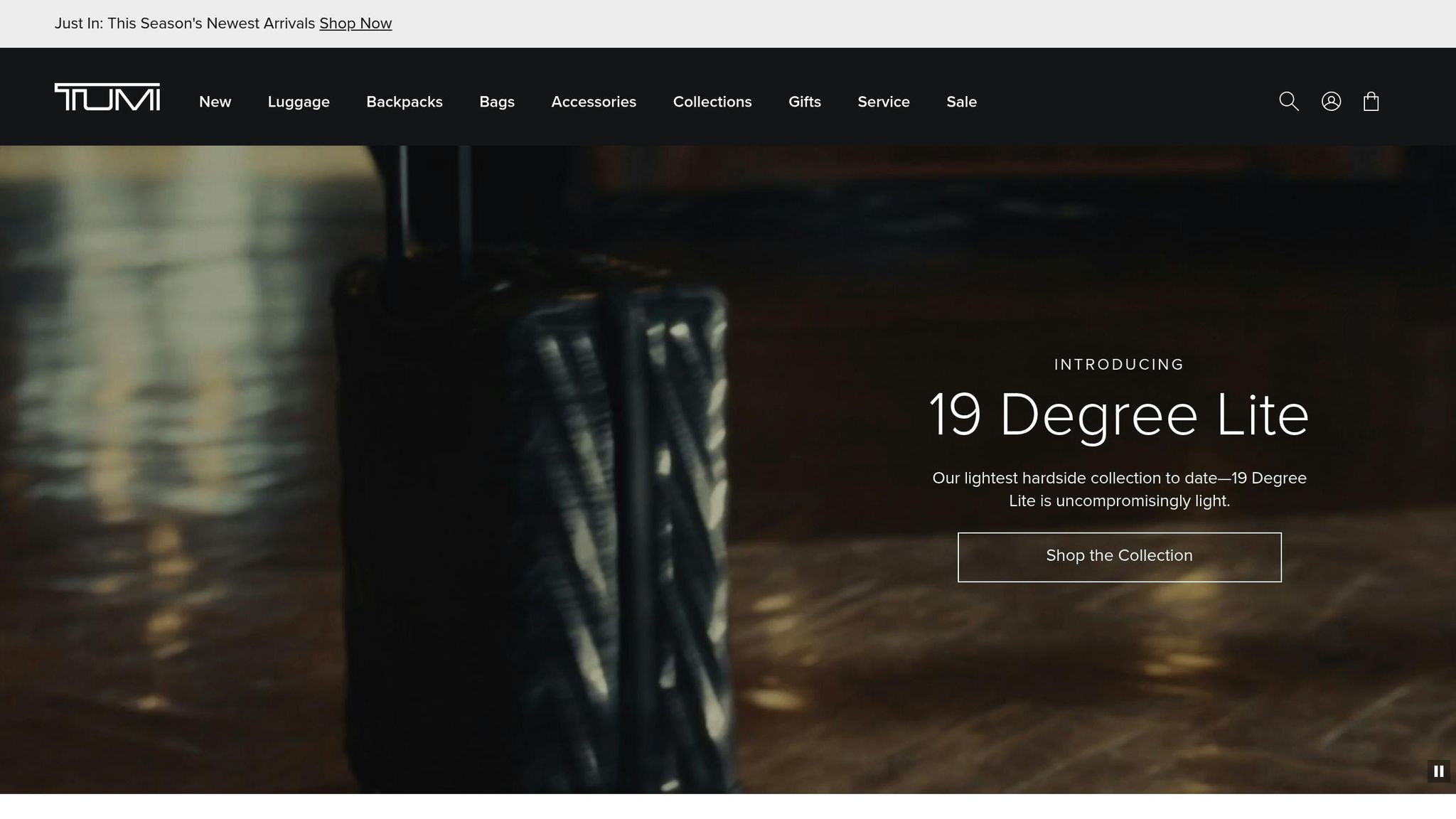To keep your Tumi backpack looking great and lasting longer, regular cleaning is key. Here’s a quick guide:
- Nylon Backpacks: Use a soft brush or cloth with mild soap and water for spot cleaning. For deeper cleaning, TUMI Fabric Cleaner or Nylon Fabric Refresher works well. Always air dry – avoid machine washing or drying.
- Leather Parts: Wipe with a dry microfiber cloth. For deeper cleaning, use a damp cloth with mild soap. Apply leather conditioner to maintain texture and prevent cracks. Avoid over-saturating leather.
- General Tips: Never use bleach or harsh chemicals. Test any cleaning product on a hidden area first. Keep backpacks away from direct sunlight and heat during drying.
- Odor Removal: Air out the bag or use baking soda to absorb smells. For stubborn odors, try wiping with white vinegar or freezing the backpack overnight.
Proper care ensures your Tumi backpack stays functional and stylish for years.
How to Clean a Tumi Nylon Bag

Tools and Products You Need to Clean Tumi Backpacks
Taking care of your Tumi backpack starts with using the right supplies to protect its high-quality materials.
Basic Cleaning Tools
For general cleaning, you’ll need a clean, lint-free cloth – this works well on all Tumi materials. A soft brush is another must-have for tackling stubborn dirt without harming the fabric. If you’re dealing with larger areas, a clean sponge helps apply cleaning solutions evenly.
When it comes to cleaning solutions, stick to mild soap and water for most materials. For leather sections, applying TUMI Leather Conditioner after cleaning can help maintain their texture and appearance.
Experts at Pattern Products recommend starting with a dry cloth, bristle brush, or sponge to remove surface dirt from Tumi nylon fabrics. For deeper cleaning, they suggest using TUMI Nylon Fabric Refresher. Simply apply it gently, wipe with a damp cloth, and let it air dry.
Once you’ve gathered your tools, it’s time to choose the right cleaning products.
Safe Cleaning Products to Use
Tumi offers specialized cleaning solutions tailored to their products. For nylon components, the TUMI Fabric Cleaner is available for $15.00. For leather care, both the TUMI Leather Cleaner and TUMI Leather Conditioner are priced at $15.00 each. These products are specifically designed to clean without harming the materials.
If you’re looking for a more affordable option, mild soap works well on nylon backpacks. Some users have even had success with everyday items like baby soap or gentle dish soap. For instance, a Reddit user managed to restore a thrifted Tumi three-way Mayport bag using a wet towel dipped in dishwashing soap – proving that household products can be effective when used carefully.
However, there are some important DON’Ts to keep in mind. Avoid using bleach, strong detergents, or abrasive cleaners, as these can permanently damage both nylon and leather. Never put your Tumi backpack in a washing machine – this can ruin its structure and void the warranty.
When applying any cleaning solution, don’t spray it directly onto the bag. Instead, spray onto a clean cloth first, then gently apply it to the material. This method prevents oversaturation and gives you better control. Always test new cleaning products on a small, hidden area to ensure they won’t stain or damage the material.
After cleaning, allow your backpack to air dry indoors, away from direct sunlight. Heat and UV rays can cause fading and weaken the materials, so choose a well-ventilated spot for drying.
How to Clean Different Tumi Backpack Materials
Tumi backpacks are crafted from various materials, and each requires a specific cleaning approach. Whether your bag is made of nylon, leather, or a mix of materials, taking the right steps can help keep it looking great and lasting longer. Below, you’ll find tailored cleaning methods for both nylon and leather components.
Cleaning Nylon Tumi Backpacks
Nylon backpacks are easier to clean than some other materials, but they still need proper care. Start by emptying all pockets and removing any detachable parts, like straps or organizers. This makes it easier to clean every surface while reducing the risk of damage.
Before using any cleaning solution, test it on a hidden area to ensure it won’t cause discoloration or harm the material. Once you’ve confirmed it’s safe, you can choose between hand washing or machine washing.
For hand washing, mix lukewarm or cold water with a small amount of mild dish soap. Avoid hot water, as it can damage nylon fibers. Use a soft brush or microfiber cloth to gently scrub in circular motions, focusing on areas that get the most wear, like the bottom and straps. Rinse thoroughly with clean water to remove all soap residue, as leftover soap can attract more dirt.
If you prefer machine washing, place your backpack in a mesh laundry bag or a clean pillowcase to protect it from getting caught in the machine. Use a gentle cycle with cold water and a mild, fragrance-free detergent. No matter the method, never put your backpack in the dryer. Instead, air dry it in a well-ventilated area, away from direct sunlight, to prevent fading or weakening of the material.
For oil-based stains, sprinkle baking soda, cornstarch, or talcum powder directly onto the stain. Let it sit overnight to absorb the oil, then brush it off in the morning.
With consistent care, these methods will help keep your nylon Tumi backpack in great shape.
Cleaning Leather Tumi Backpacks
Leather backpacks require more delicate care to maintain their premium look over time. Regular maintenance is key to preserving their appearance and durability.
Start by wiping off dust and dirt with a soft, dry microfiber cloth. This simple step helps prevent particles from embedding into the leather and causing permanent stains.
For a deeper clean, lightly dampen a cloth with a mild soap solution and gently wipe the leather. Avoid over-saturating the material, as too much moisture can lead to cracking or mold. To keep the leather soft and supple, apply a leather conditioner in circular motions using a clean cloth. In dry climates, conditioning may need to be done more frequently. After applying the conditioner, wipe off any excess with a dry towel to prevent residue buildup.
Minor scratches can be treated with a small amount of coconut or olive oil. For deeper scratches, use a leather cleaner that matches the backpack’s color, followed by a conditioner. For extensive damage, it’s best to consult a professional.
When dealing with stains, patience is crucial. For common stains, use a cotton swab dipped in lukewarm water to spot clean. Stubborn marks, like ink stains, may require a mild leather cleaner or a mixture of baking soda or cornstarch applied with a damp microfiber cloth.
"Start by removing any security stickers or tags . . . and clean off any excess surface dirt."
- Victor Sanz, Creative Director at Tumi
Proper storage also plays a big role in leather care. Store your backpack in a cool, dry place, and use a dust bag or breathable fabric cover to protect it. Avoid plastic bags, as they trap moisture and can lead to mold. If storing for a long time, fill the backpack with tissue paper or soft cloth to help it keep its shape.
For backpacks made of both nylon and leather, clean each material according to its specific needs. Use fabric cleaner for nylon sections, leather cleaner for leather parts, and mild soap and water for plastic components.
Climate also affects leather care. In dry conditions, condition the leather more often to prevent cracking. During rainy seasons, apply a protective spray in a well-ventilated area to shield against water damage. If the leather gets wet, gently blot it with a microfiber cloth and allow it to air dry naturally before reconditioning.
sbb-itb-1e6451b
How to Fix Common Cleaning Problems
Even with regular upkeep, stubborn stains and unpleasant odors can still pop up. Here’s how you can tackle these common cleaning issues while keeping your backpack’s premium materials in great shape.
Getting Rid of Stains
For stains, start gently. Dab fresh stains with a clean cloth to absorb as much as possible. Then, use a soft microfiber cloth and a diluted baby soap solution to carefully clean the area. Repeat the process if needed, but avoid scrubbing too hard – this can damage the material.
If the stains are gone but odors remain, it’s time to move on to the next step.
Removing Bad Smells
To get rid of odors, turn the backpack inside out and let it air out in a well-ventilated space. For smells that won’t budge, try placing an open container of baking soda inside the bag overnight – it’s great at absorbing odors. Alternatively, wipe down the interior with a cloth dampened with white vinegar. For extreme cases, seal the backpack in a clean plastic bag and leave it in the freezer overnight. This can help eliminate deeply embedded smells.
Cleaning Removable Parts
Detach any removable parts like straps, buckles, or organizational inserts before cleaning. Wash fabric components by hand using mild soap and lukewarm water, then rinse thoroughly and let them air dry. For plastic and metal hardware, use a damp cloth with a mild soap solution, and a soft brush to clean any crevices. Make sure all parts are completely dry before putting everything back together to prevent moisture damage.
How to Keep Your Tumi Backpack in Good Shape Long-Term
Taking care of your Tumi backpack ensures it stays functional and stylish for years. Beyond basic cleaning, there are specific steps you can take to maintain its durability and premium appearance. Here’s how you can avoid common mistakes, store it properly, and care for leather components.
Mistakes That Damage Your Backpack
- Never put your backpack in a washing machine or submerge it in water. Stick to spot cleaning with a damp cloth.
- Avoid using harsh cleaning products, as they can damage the material.
How to Store Your Backpack Properly
Proper storage is just as important as cleaning when it comes to preserving your backpack. Keep it in a cool, dry space away from direct sunlight and extreme temperatures. Before storing, empty all the compartments and pockets, and clean the backpack following the manufacturer’s guidelines. Make sure it’s completely dry to prevent mold or mildew from forming.
To help your backpack retain its shape, stuff it with clean, acid-free tissue paper. Check on it periodically to ensure there are no signs of wear or mold. These small steps can go a long way in keeping your backpack in excellent condition.
When to Use Leather Conditioner Again
If your Tumi backpack features leather components, conditioning the leather is key to preventing cracks and keeping it soft. Apply a leather conditioner twice a year – or more frequently (three to four times annually) if it’s regularly exposed to sunlight. Use a lint-free cloth to apply a thin, even layer of conditioner, and let it dry for at least two hours before buffing it gently. For older or very dry leather, you may need to apply an additional coat.
Tumi offers a leather care kit designed specifically for their products, which helps maintain the leather’s softness and color.
TUMI’s FAQ advises testing their leather conditioner on a small area first. Apply it with a soft cloth, allow it to dry, and then buff gently to preserve the leather’s luster and soft texture. [10]
Regular conditioning not only keeps the leather looking great but also adds a protective layer against moisture and daily wear. Taking these steps ensures your Tumi backpack remains as impressive as the day you got it.
Key Points for Cleaning and Caring for Tumi Backpacks
To keep your Tumi backpack in top shape, consistent care tailored to its materials is essential. Avoid machine washing, as it can lead to damage, and instead, use specific cleaning methods for nylon and leather components.
For nylon backpacks, begin by brushing off any loose dirt with a clean, dry cloth. Use TUMI’s recommended nylon fabric refresher to gently treat stains. Once applied, wipe the area with a damp cloth and let it air dry naturally.
Leather parts require extra attention. Always test any cleaning or conditioning product on a hidden section first. Apply a leather conditioner with a soft cloth, let it dry, and then buff it to maintain its appearance.
Quickly addressing spills and handling zippers carefully can also protect your backpack. Repair expert Tercel Fayad from Big Agnes advises, “Keeping your zippers clean will extend their life”. Additionally, avoid overloading your backpack or placing it on abrasive surfaces to prevent scratches or deformation.
FAQs
How do I clean a Tumi backpack with both nylon and leather materials?
To clean a Tumi backpack made with both nylon and leather, begin by addressing the nylon sections. Use a damp cloth with a small amount of mild soap to gently scrub away dirt and stains. Once clean, take another damp cloth to remove any soap residue. For the leather parts, grab a soft cloth and apply a good leather conditioner after cleaning to maintain its flexibility and protect it from wear. Steer clear of harsh chemicals or too much water, as these can harm both the nylon and leather materials.
How can I keep my Tumi backpack fresh and odor-free?
To keep your Tumi backpack smelling clean, start by airing it out regularly. Leave it open in a well-ventilated space to let any trapped odors escape. For an extra boost, sprinkle a little baking soda inside to help absorb unpleasant smells, or use a gentle fabric-safe odor eliminator spray. Always ensure your backpack stays clean and dry, and avoid putting damp items inside. If you’re looking for long-term odor control, consider using products with antimicrobial features to reduce bacteria that can cause bad smells.
Can I use household cleaning products to clean my Tumi backpack, and which ones are safe?
When it comes to cleaning your Tumi backpack, you can safely use certain household cleaning products, but the key is selecting ones that suit the material of your bag.
For nylon backpacks, a simple mix of mild soap and warm water does the job. Use a soft cloth or sponge to gently clean the surface, and then allow it to air dry naturally.
If you’re dealing with a leather backpack, stick to a leather-specific cleaner and conditioner. These products help preserve the leather’s texture and prevent it from cracking over time.
One important tip: steer clear of harsh chemicals like bleach, ammonia, or abrasive cleaners. These can harm the fabric or finish of your backpack. And before diving in, always test any cleaning product on a small, hidden spot to make sure it won’t cause discoloration or damage.




 Mobile/What's App/Wechat
Mobile/What's App/Wechat E-Mail
E-Mail ADD
ADD




